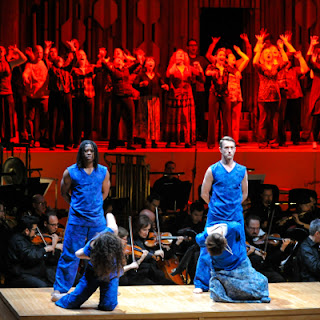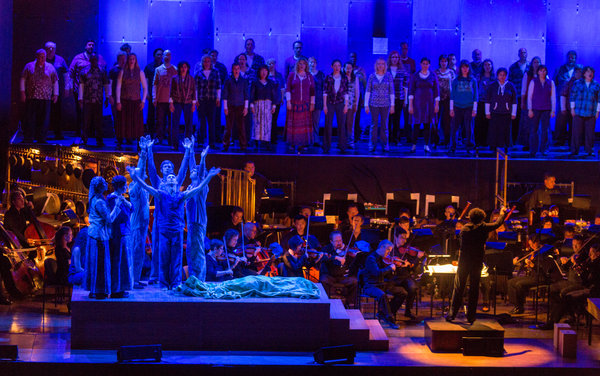Last week, under the cool springy hair and steady hands of LA Philharmonic’s dynamic Gustavo Dudamel, Avery Fisher Hall held the New York premiere of John Adams and Peter Sellars’ most recent collaboration, The Gospel According to the Other Mary. The crowd seemed noticeably more excited, and aggressive, than the usual tame Avery Fisher vibe. Not only did they need actual ID at the Will Call window, but the line for security took awhile although we did get to keep our shoes on. And the lines for the restrooms, forget about it. Tickets were completely sold out and from what we could see from the second to last row of the hall, every seat was filled. Our perspectives differed wildly after that.
Elizabeth – This was unlike any orchestral presentation that I have ever seen. A large elevated solid platform at the back of the stage quickly filled with young men and women in casual clothes, the chorus. A very full stage held the LA Philharmonic, and at the very front edge of the stage was a table and a small block solid platform. The main singers would move between the two.
The music sounded like a movie score—there were sudden shifts in tone and tempo and later, slow rising peaks and valleys. It was rich and nuanced and at points I simply closed my eyes and listened to the orchestra. Had there been no voice added to the piece, it would have still been a moving evening. Add in the vocals, dance and the various story lines in the piece, and well…you’ve got an interesting mix.
I’ll be honest. I thought the singers were vocally solid and great, but I eventually tired of the lyrics, and the uninteresting melody. I simply did not like the words as sung or the melody written for it. The libretto is interesting to read, but the singing of it was uninspiring and I was bored. At first I was trying to figure out where the characters were going—we switched between Mary as “the other Mary” in the Bible and then Mary as woman in modern society and travelled around the globe. I tried to deconstruct the piece: I thought the idea of Jesus being portrayed as three individual men was neat, and other points it appeared that the group of lead singers were all depicting Jesus—the shifting of characters was thought provoking. And the use of modern dance was also great at times. I liked Mary dancing on the ground next to Jesus, like a wave of water rising up around him. In other parts the dance just seemed like filler. Ultimately this was my main issue with the production: there seemed to be minimal staging, which is great in that it leaves the piece open to interpretation, but at points it was just too barebones.
 I couldn’t tell where Adams and Sellers were trying to take the audience. I liked the music very very much, but the singers were in this awkward in between place where they weren’t just standing and singing to the audience like a recital, but also weren’t fully relaying a story. It simply felt weird. I suspect others were feeling the same way, as many people left during the first half. Some audience members even caused others to have to get up so they could leave. I’ve never encountered that at a performance. It was striking that people couldn’t even wait until the intermission to leave. Many more left during the intermission. I can’t say that I blamed them. Had it not been for my fiancé, I probably would have left. During the second half I spent most of my time either with my eyes closed listening to the orchestra or focused solely on Dudamel and his huge personality and entertaining style of conducting. I think that with a different conductor I may not have made it through.
I couldn’t tell where Adams and Sellers were trying to take the audience. I liked the music very very much, but the singers were in this awkward in between place where they weren’t just standing and singing to the audience like a recital, but also weren’t fully relaying a story. It simply felt weird. I suspect others were feeling the same way, as many people left during the first half. Some audience members even caused others to have to get up so they could leave. I’ve never encountered that at a performance. It was striking that people couldn’t even wait until the intermission to leave. Many more left during the intermission. I can’t say that I blamed them. Had it not been for my fiancé, I probably would have left. During the second half I spent most of my time either with my eyes closed listening to the orchestra or focused solely on Dudamel and his huge personality and entertaining style of conducting. I think that with a different conductor I may not have made it through.
 Shawn – Peter Sellars has been in my consciousness for almost as long as I can remember. His Don Giovanni production set in the Bronx I particularly remember although I never actually saw it. What I remember is as a child the criticism of the production from the adults around me seeping down to my tiny ears. I do remember that my mother liked it however. He was spoken of as a renegade and that fascinated me in and of itself. Now he is almost an elder statesman of theatre. Interesting how things change. I recently learned that amongst of his undergraduate projects at Harvard was an all puppet version of the Ring Cycle (which he performed himself apparently) and a production of Anthony and Cleopatra in a swimming pool. Some projects for an undergrad.
Shawn – Peter Sellars has been in my consciousness for almost as long as I can remember. His Don Giovanni production set in the Bronx I particularly remember although I never actually saw it. What I remember is as a child the criticism of the production from the adults around me seeping down to my tiny ears. I do remember that my mother liked it however. He was spoken of as a renegade and that fascinated me in and of itself. Now he is almost an elder statesman of theatre. Interesting how things change. I recently learned that amongst of his undergraduate projects at Harvard was an all puppet version of the Ring Cycle (which he performed himself apparently) and a production of Anthony and Cleopatra in a swimming pool. Some projects for an undergrad.
 I found much of the libretto striking though in researching it the lines I found most powerful were not Sellars’ own but of the Native American poet/author Louise Erdrich. A variety of poets and authors were used and I’m not sure what if any of the libretto was Sellars own words. Regardless, weaving the various verses together in such a fashion as to tell this story is no small feat alone.
I found much of the libretto striking though in researching it the lines I found most powerful were not Sellars’ own but of the Native American poet/author Louise Erdrich. A variety of poets and authors were used and I’m not sure what if any of the libretto was Sellars own words. Regardless, weaving the various verses together in such a fashion as to tell this story is no small feat alone.
 Overall I don’t think the piece is fully fleshed out yet theatrically. Sellars and Adams have stated they purposefully left it open enough to be staged in a variety of ways. From concert to more in depth full stagings. They did not want a fully realized stage opera version for this reason to allow the piece to adapt to different venues of various sizes and styles. As it is performed more it will find its center theatrically, probably more than one, with different theatrical and dramatic shadings depending on the production. One of the hallmarks of a great piece of art no?
Overall I don’t think the piece is fully fleshed out yet theatrically. Sellars and Adams have stated they purposefully left it open enough to be staged in a variety of ways. From concert to more in depth full stagings. They did not want a fully realized stage opera version for this reason to allow the piece to adapt to different venues of various sizes and styles. As it is performed more it will find its center theatrically, probably more than one, with different theatrical and dramatic shadings depending on the production. One of the hallmarks of a great piece of art no?
– Elizabeth Frayer and Shawn E Milnes
Related Articles:
Discordant Fellatio: Powder Her Face (NYCO at BAM)
Ferruccio Furlanetto and the Heretic Burning Factory: Don Carlo at the Metropolitan Opera
How Hollywood Films Are Killing Opera?!?
Rick Santorum To Take Over As General Manager of Metropolitan Opera




Leave a Reply